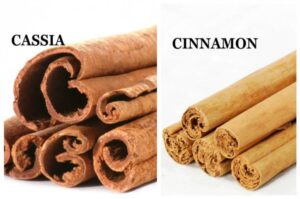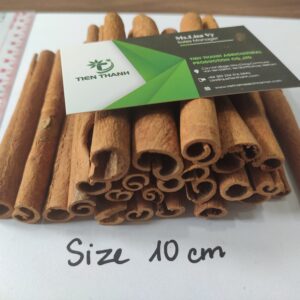CASSIA Vs CINNAMON

Though often used interchangeably, cassia and cinnamon are not the same. Cinnamomum cassia (grown primarily in China and Indonesia) is reddish-brown and pungently sweet, while Cinnamomum zeylanicum (from Sri Lanka and India) is buff-colored and mild. Cassia is usually preferred for its more intense color and flavor.
About Cassia
 Cassia Called Cinnamon cassia – that most popular of spices – comes from the bark of an evergreen tree. Cinnamon’s sweet, spicy and warm fragrance adds pungent sweetness to your favorite baked goodies. You can also use it to add a depth of flavor to savory dishes as well.
Cassia Called Cinnamon cassia – that most popular of spices – comes from the bark of an evergreen tree. Cinnamon’s sweet, spicy and warm fragrance adds pungent sweetness to your favorite baked goodies. You can also use it to add a depth of flavor to savory dishes as well.
Cinnamon Cassia is the world’s most popular baking spice. You’ll recognize its familiar taste and aroma in cakes, breads, cookies, breads and pies, dumplings, puddings, pastries and ice cream. It’s common in savory dishes, too–soups, chutneys, catsup, pickles, squash, vinegars and meat glazes–and hot drinks like cider, coffee, tea and cocoa.
Cinnamon Cassia complements fruits like apricots, cherries, apples, blueberries and oranges. Vegetables, too–especially carrots, spinach and onions–are enhanced by cinnamon’s pungent sweetness.
In combination with other spices (like cloves, nutmeg, cardamom, ginger, allspice, and black pepper), cinnamon cassia shows up in a wide array of spice blends, including pumpkin pie spice, apple pie spice, cider blends, five spice powder, curries , pickling spice, even popcorn seasoning!
The variety of cassia
Korintji (thick quill cinnamon) and Batavia (thin quill cinnamon) are two types of C. cassia . Korintji comes from a higher altitude than the Batavian and has a slightly more intense reddish-brown color and sharp cinnamon flavor; it’s considered the best variety. There are many species of cassia, including C. aromaticum (from China), C. burmannii (from Indonesia), and C. loureirii (from Vietnam or Saigon).
Vietnamese (Cinnamomum loureirii)
Formally known as Saigon cinnamon, this special variety is rebounding in popularity in the US, following a more than 20-year absence. Compared to Indonesian types, Vietnamese cinnamon has a distinctly sweet flavor and an exceptionally high volatile oil content. Gourmet cooks rate it as the highest quality cinnamon in the world.
Chinese (Cinnamomum aromaticum)
Chinese cinnamon possesses characteristics similar to those of Vietnamese cinnamon, but with a less intense flavor. In China, the bark is typically peeled from the trees starting at 10 years of age and continuing as long as 30 years.
Indonesian (Cinnamomum burmanii)
The most commonly found cinnamon in American kitchens is Indonesian cassia. It is sourced from higher elevations and is harvested a bit earlier than Chinese and Vietnamese cinnamons. Korintje translates the “thick quill” and is judged for quality based on the part of the tree that is harvested (trunk vs. branch) and on the length of the bark peeled from the tree. We bring you the highest quality Korintje cinnamon available.
To harvest Cassia, the inside pulp of the evergreen is scraped out, then ground, and the quill pieces (cinnamon sticks) are selected for drying and grading according to size, color and quality. Trimmings and waste pieces are sold as cinnamon chips or used to distil the essential oil. The cinnamon is then graded according to quality. Grade A cinnamon has the highest oil content and the most intense flavor and aroma. In addition, quills harvested for Grade A cinnamon must be one meter long and taken from the main trunk of the tree.
Cassia is valued today for its carminative, antiseptic and astringent quality, and its medicinal significance is still being explored. Dr. Richard Anderson, Ph.D., lead scientist at the Beltsville Human Nutrition Research Center in Beltsville, Maryland, for example, found that compounds in cinnamon improve the body’s ability to use insulin to improve blood glucose levels. These findings are promising, especially for diabetics.
The history of cassia is laced with legend, exotic trade routes and struggles for monopoly. The ancient Chinese believed that the cassia tree–which flourished in the Garden of Paradise on the Yellow River–was the “Tree of Life.” Eating its fruit, they said, led to immortality. Ancient Egyptians used cinnamon for medicinal purposes and embalming, and the ancient Romans enjoyed it in wines and as a fragrance, beauty-salve and aphrodisiac. When Nero killed his wife, Poppaea Sabina, he had all the cinnamon in Rome (a year’s supply of imports) burned in homage at her funeral.
About Cinnamon
Cinnamon call Ceylon cinnamon, True cinnamon, is obtained from C. verum, grown in Sri Lanka. It’s tan and very mild.
Ceylon (Cinnamomum verum) – This cinnamon is native to Sri Lanka (though grown in India, the East and West Indies, and Central America). The cultivated variety grows 8 to 10 feet and resembles a shrub rather than a tree. Most of the product in the US is sold in the stick form.
Columbus sought this exotic spice, and in 1505 it was “discovered,” in Ceylon (now Sri Lanka) by the Portuguese explorer Lorenzo da Almeida. Control of the cinnamon trade meant power; in 1760, all of Holland was scented when Amsterdam’s cinnamon supplies were burned in an effort to keep prices up. At the same time, the penalty for the illegal sale of a single stick of cinnamon during Dutch control was death!
Ceylon Cinnamon Is So Expensive
Ceylon cinnamon is native to just one region of the world. And producing it requires hours of delicate work. Even the most skilled workers can make only a few pounds of quills a day. One pound of cinnamon quills can cost $27
Take Home Message
Both Ceylon and cassia are healthy and delicious.
However, if you intend to consume large amounts of this spice or take a supplement, cassia can be harmful because of the coumarin content.
At the end of the day, Ceylon cinnamon is better quality and much safer.
Thank for your time!
Lisa (Ms)
Sales Manager
—————————
Email: Lisa@quetienthanh.com
Tel : +84-21-62201888 Phone/WhatsApp/Zalo: +84 383 234 316
Website: vietnamesecinnamon.com
————————————————
TIEN THANH AGRICULTURAL PRODUCTION CO.,LTD.
Office: Cau Vai Village, Mau Dong Commune, Van Yen District, Yen Bai Province, Vietnam.
Factory: Minh Khai Village, Quang Minh Commune, Van Yen District, Yen Bai Province, Vietnam.


